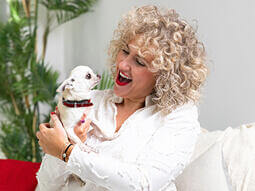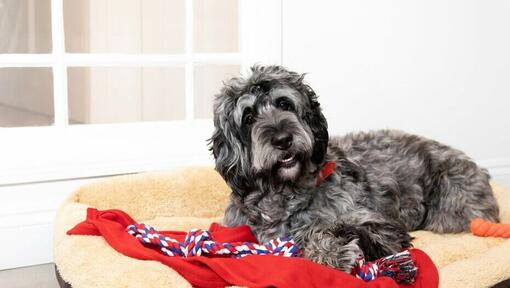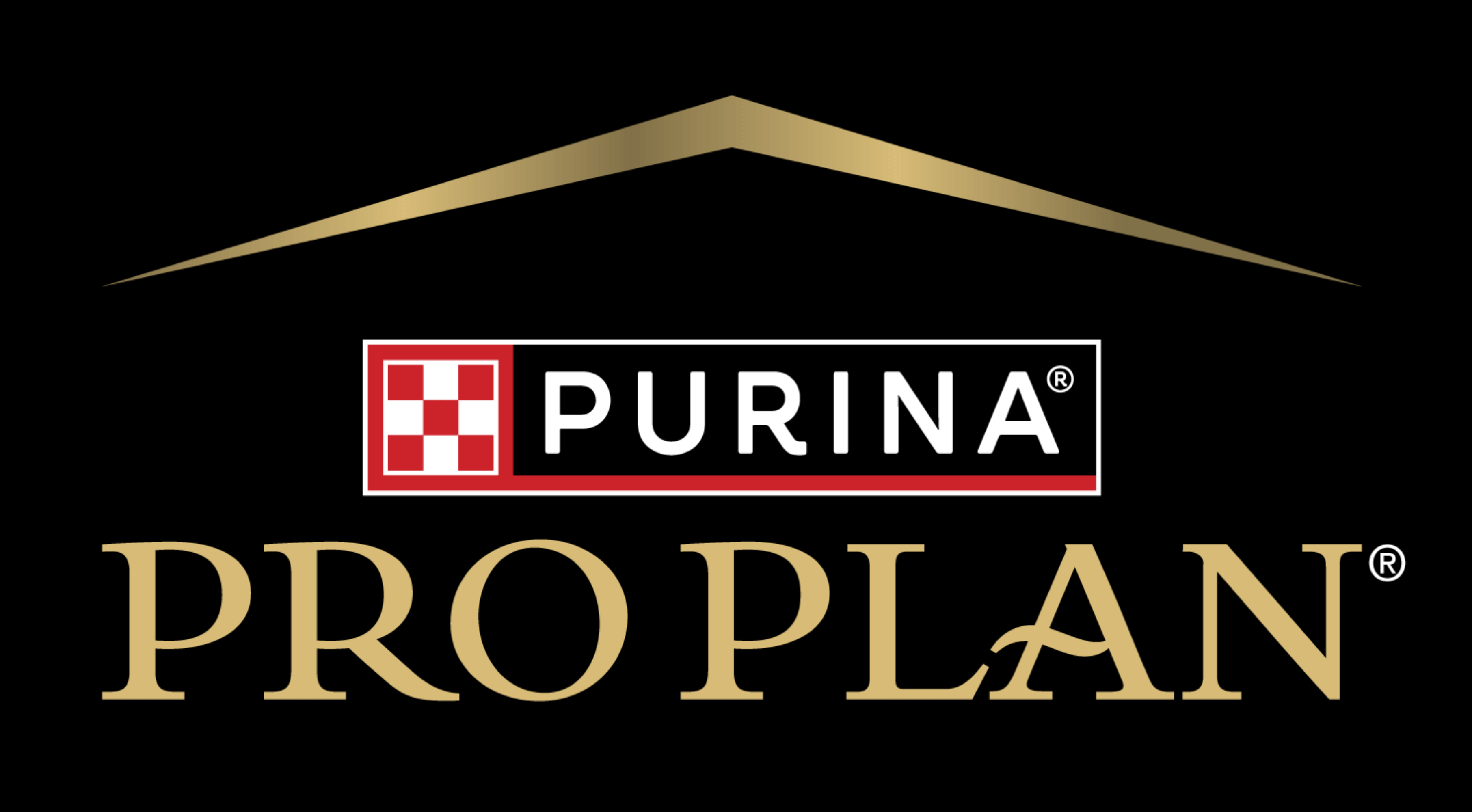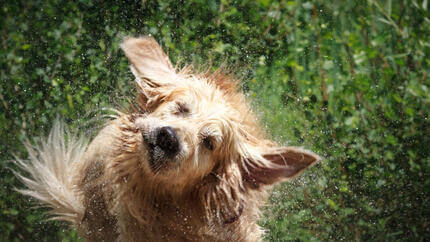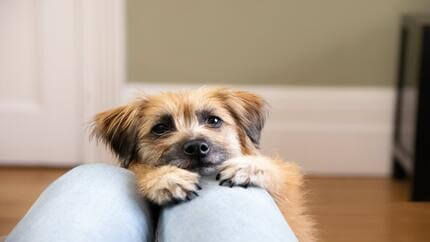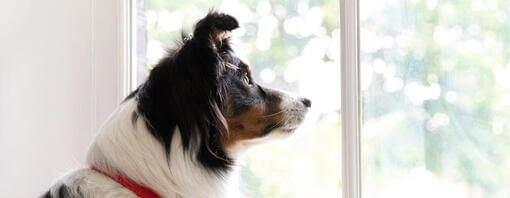
For those of us who are spending an extended period at home, the extra time we get to spend with our dogs is great of course – but, it’s a reality that we are likely to return to work at some point which will be a huge change for your dog. Learn how to ease your dog into being left home alone with our guide.
Finding yourself at home for an extended period of time can bring mixed emotions. Whether you’re unwell, taking a career break, on maternity/paternity leave or locked down due to a global pandemic, the change to your routine will impact you and your dog in different ways. While time with your dog is always a good thing, they will be affected by your emotions as you navigate your new situation and there are inevitable changes in your behaviour. You might notice changes in your dog’s behaviour too; are they following you around the house, becoming anxious when you leave to go shopping or finding places to hide around the house? It’s your responsibility to make sure that their world doesn’t come crashing down around them when your routine changes again.
But before we get to the most effective ways to establish a routine for your pet, here are some of the most common symptoms for a dog struggling with change.
Dog stress symptoms
If your dog is going through a change in their life, it’s important that you keep a look out for any dog stress symptoms, which may indicate that they’re having a difficult time coping:
- Excessive howling or barking
- Going to the toilet in the house
- Lack of interest in food and play
- Digestive issues such as diarrhoea
- Increased sleeping
- Aggressive dog behaviour
- Destructive behaviour
The key to success will be the routine you put in place for your dog. It needs to blend their daily needs with the lifestyle you will be leading when you’re no longer at home most of the time. Whether you are bringing a puppy into your family, a rescue dog or your current canine family member is experiencing a change in their routine, it’s important to adopt a daily routine.
Teaching your dog independence as a way of coping with change
Encouraging independence involves teaching your dog that they’re safe to entertain themselves, focus on solo activities and settle alone.
The best way to do this is by creating a daily routine. That way, they know what’s expected of them, they know what’s coming next and they won’t be confused by any sudden changes.
Think about where your dog would be left alone when you’re not at home. This space needs to be comfortable for them; a familiar space that they’re used to relaxing in and the time they spend there can be built up slowly if they are no longer used to being alone.
As much as you love spending time with your dog, encouraging independence is one of the kindest things you can do for them as they’re experiencing change with you.
Daily dog routine: getting started
The best time to start a routine is the moment your dog joins your family. The second best time is now! Regardless of whether your dog used to have a routine which has now changed or they have joined your family during a time that doesn’t represent your usual day-to-day life; start now and start small.
Write down the daily routine that you will commit to and make sure that everyone involved in the dog’s care is in agreement.
Make sure that when your dog is having time alone, that doesn’t become time when they’re snoozing next to you on the sofa. They need to be comfortable being away from you. Start by choosing two or three tasks a day that you can complete while your dog is relaxing in the space they’ll be left in when you’re not at home.
If you’re worried that your dog isn’t going to cope with being left alone, you can start with small games that you set up but don’t engage with your dog while they enjoy them. If you scatter some of their daily food allocation around the garden or in a cardboard box with shredded paper, they will be focused on a natural behaviour and learn that they can enjoy time by themselves. It’s much more fun for a dog to sniff out their dinner than to inhale it from their bowl.
Getting your dog used to the new routine
Creating a routine will help your dog. They are creatures of habit and a routine helps them to feel secure in their environment. From a place of security, dogs are better able to deal with change.
The daily routine that you create needs to be maintained regardless of what is going on around you.
For example, in the morning your dog will be exercised and after a rest, will have their breakfast. They will then settle and have some time alone. There will be time scheduled for play around midday and in the afternoon they have an activity that they can enjoy by themselves. After their evening walk, they have a rest and dinner before spending time with you. They’ll have their pre-bedtime toileting opportunity and then go to sleep. For puppies, the routine will include many more toilet opportunities!
Remember that dogs need 14-16 hours rest so by giving them the time they need to do that, you’re absolutely doing the right thing.
By adopting a routine like this, you can maintain it regardless of the changes you’re experiencing. The ‘exercise’ time can involve a number of different things if you’re not able to walk as far as usual, you need to ask someone else to walk your dog or you’re designing treat trails around the house/garden. Playtime can be a short training activity that will not only help your dog but will enhance the bond that you both have. The solo activity can be a pre-prepared brain game, a Kong or a long-lasting treat which will switch their focus from you to something they can enjoy by themselves. Within the routine, there’s room for improvisation, but your dog will be much more secure in their environment if they know what to expect.
The house rules
It’s not easy to leave your dog in another room while you’re at home, but it’s vital for their well-being. Along with creating your daily routine, make sure you have house rules in place, especially if you have children at home. Your dog’s safe space is a no-go area. They need to know that they can retreat to that place when they need time out.
Your dog needs their rest and if they are constantly being disturbed and they don’t have a place to rest that they know is safe, they could get grumpy. By leaving them alone in their safe space, you are showing them that you can be trusted and that’s the basis for a harmonious relationship.
How to help your dog deal with other changes at home
New home
The first step you should take when moving home with your dog is to double-check that the place you’re moving to is pet-friendly. According to Vet Street, moving home is one of the top reasons why dogs and cats are given to rehoming centres each year, and this is largely due to the new home having a no pet policy.
When you begin the moving process it can be a very stressful time for your dog, which is why many decide to board their dog in a kennel, or have them stay with friends or family for the duration of the move. By doing this it not only keeps them safe and out of the way of the movers, but also can make them feel calmer as moving home is a busy time. When considering how to settle a dog into a new home, before collecting them we recommend unpacking some of their familiar things, as this will help to reduce stress and make them feel more at home.
If your dog has to stay with you for the duration of the move, then put them in a quiet room with the door shut whilst everything is packed and loaded up. This will ensure that your dog is safe at all times and that you’ll know where they are when the time comes for them to move. Then once you get to the new home unload some of their things straight away and allow them plenty of time to settle in.
Divorce
Divorce or a breakdown of a relationship can be really upsetting, and many owners forget about the impact it has on their dog. For your dog, your partner could have been their play companion and they might have spent a lot of time having fun with them, so when that person is no longer there, they may experience separation anxiety.
The easiest way to help your dog adjust painlessly is by slowly allowing them time to get used to it. If this is an option, once you know what your new schedule will look like, start working this in as early as possible, this will make it much easier and can help to avoid severe dog stress symptoms.
If slowly introducing the new schedule isn’t an option, you can help your dog by keeping their routine as normal as possible. Ensuring that you reinforce good behaviour and ignore bad behaviour is essential during the adjustment process. For example, if your dog is crying at the door the best thing to do is ignore them. Then when they’re quiet again, give them lots of fuss and comfort. It’s also a good idea to use exercise as a distraction to get rid of any anxious energy. Try stimulating their brain with some treat or puzzle toys, or start taking them for longer walks to tire them out.
Separation anxiety
If your dog doesn’t respond to their new routine or the gradual build-up of time alone, you will need the support of a behaviourist. Some dogs do struggle with being left alone and may experience separation anxiety, especially if they have become used to your company on a more permanent basis. They might display destructive behaviour at home or have toileting accidents when they’re left or they might bark or howl when you leave. You can help them, but you will need support to do this in a way that’s designed for you and your dog.
You know your dog and you are their best advocate. If you start to see changes in their behaviour and you hear yourself saying ‘s/he’s getting worse’ then ask yourself how you can best help your dog. If they used to settle quite happily but they’re now following you around, something has changed. If they used to watch as you left the house, but now they’re barking as you shut the door, something has changed. Think about what your dog’s normal routine looked like before those changes and acknowledge the differences in the behaviour they’re displaying now, no matter how small. You can start by following the steps detailed here and consult a behaviourist for the best advice on how to help your dog.
Want to learn more about your dog’s behaviour? Read our guide on helping a scared dog, next.
